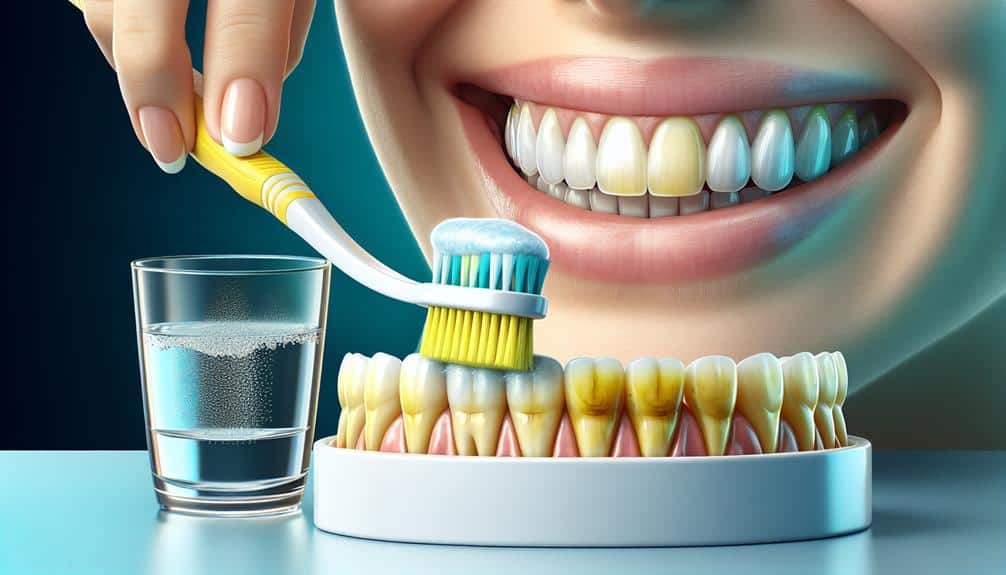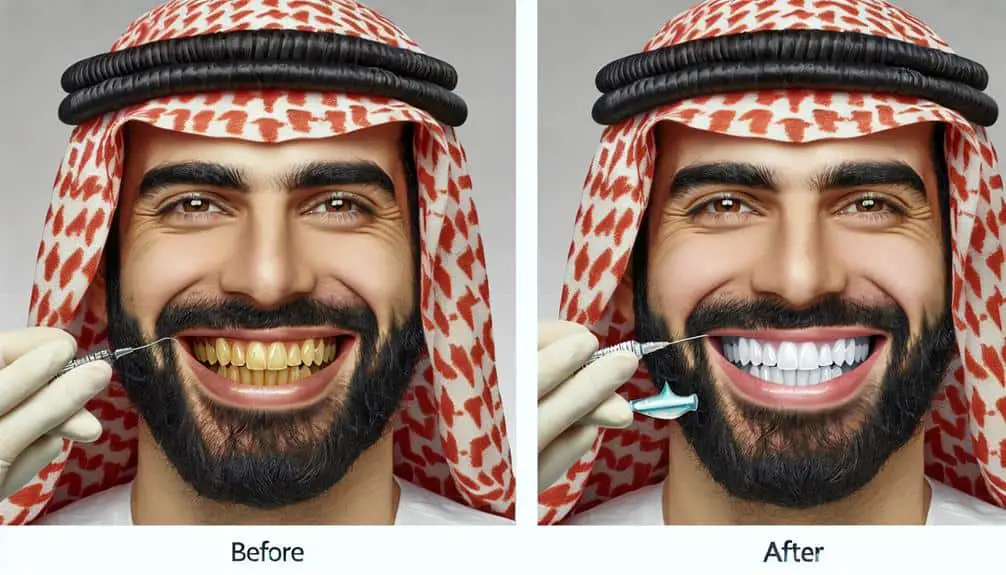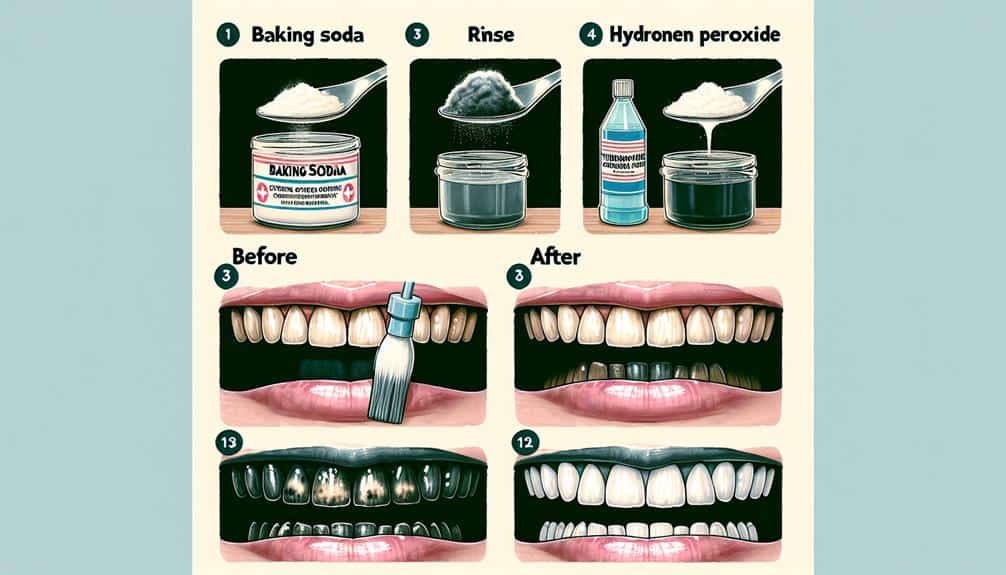When tackling tetracycline stains on your teeth, consider professional whitening treatments for their effectiveness and advanced solutions. At-home whitening kits containing bleaching agents are convenient and powerful, but consult a dental professional for tailored advice. Dental veneers are great for concealing stains, yet discuss potential risks and costs with a dentist. Microabrasion offers a minimally invasive procedure to improve tooth color, while bonding and contouring are quick, conservative methods for enhancing your smile. Start with these methods to address tetracycline stains effectively, and discover more ways to restore your smile's full potential.
Key Points
- Professional whitening treatments effectively eliminate tetracycline stains with advanced solutions.
- At-home whitening kits offer convenient and effective options containing bleaching agents.
- Dental veneers can effectively conceal tetracycline stains, custom-made for natural-looking results.
- Microabrasion is a minimally invasive procedure preserving enamel and improving tooth color uniformity.
- Bonding and contouring are quick, minimally invasive procedures to enhance teeth without extensive work.
Professional Whitening Treatments
To effectively eliminate tetracycline stains from teeth, consider professional whitening treatments. Professional whitening treatments offer advanced solutions to combat stubborn discoloration effectively. One such method is laser therapy, which is enamel safe and can target deep-seated tetracycline stains with precision. This cutting-edge technology guarantees that the surrounding enamel remains unharmed while effectively breaking down the stains, providing remarkable outcomes.
Another popular professional whitening treatment is chairside bleaching, known for its quick results. This procedure is performed in the dentist's office, allowing for immediate improvement in the appearance of tetracycline-stained teeth. Chairside bleaching is a convenient option for individuals seeking a fast and efficient way to address their dental discoloration issues.
When considering professional whitening treatments for tetracycline stains, it's essential to consult with a qualified dental professional. They can assess your specific needs and recommend the most suitable treatment option to achieve excellent results.
At-Home Whitening Kits
Consider utilizing at-home whitening kits as a convenient and effective solution for addressing tetracycline stains on your teeth. At-home whitening kits offer the flexibility of do-it-yourself whitening in the comfort of your own home. These kits typically contain a bleaching agent, such as hydrogen peroxide, that helps to lighten stains on the enamel of your teeth. When used as directed, these kits can gradually improve the appearance of tetracycline stains.
It's crucial to follow the instructions provided with the at-home whitening kit carefully to achieve best results while minimizing any potential side effects. Many kits also come with desensitizing agents to help reduce tooth sensitivity, a common issue with whitening treatments. Additionally, if you prefer natural remedies, some at-home whitening kits offer more natural ingredients that can be gentler on your teeth while still effectively combating stains.
Before starting any at-home whitening treatment, it's advisable to consult with your dentist to make sure it's the right option for you and to discuss any potential risks or concerns.
Dental Veneers
Explore how dental veneers can effectively conceal tetracycline stains on your teeth, providing a lasting solution for enhancing your smile. Veneers, thin shells made of porcelain or composite resin, offer numerous benefits. They're custom-made to match your natural teeth in color, shape, and size, providing a natural-looking result. Veneers are stain-resistant, making them a long-term solution for hiding tetracycline stains. However, it's vital to contemplate the risks associated with this procedure, such as potential damage to the underlying tooth structure during the preparation process.
When comparing the cost of veneers to other treatments, it's crucial to bear in mind that veneers tend to be more expensive upfront. Yet, they're durable and can last for 10-15 years with proper care. This cost comparison should also take into account the long-term benefits of veneers, such as their ability to improve your smile's appearance permanently. Before opting for veneers, consult with a dental professional to determine if this treatment is the right choice for your specific needs.
Microabrasion
Enhance your smile by exploring the benefits of microabrasion, a minimally invasive dental procedure that effectively removes surface stains and imperfections from your teeth. Microabrasion is known for its enamel preservation properties, making it a safe option for restoring the natural beauty of your teeth. This technique involves using a combination of mild abrasive compounds and gentle abrasion to remove superficial stains without causing damage to the enamel.
From a clinical effectiveness standpoint, microabrasion has shown remarkable results in improving the appearance of teeth affected by tetracycline stains. Not only does it address surface discoloration, but it also helps in achieving a more uniform tooth color. When considering cost comparison, microabrasion is often more affordable than other extensive treatments like veneers or crowns.
Additionally, the long-term success of microabrasion largely depends on maintaining good oral hygiene practices and regular dental check-ups. Embracing microabrasion can lead to a brighter, more confident smile with minimal invasiveness and lasting results.
Bonding and Contouring
To address minor imperfections and enhance the appearance of your teeth, bonding and contouring procedures offer a minimally invasive solution with effective results. Bonding involves the application of a tooth-colored resin material to the tooth surface, which is then sculpted, shaped, and polished to match the surrounding teeth. This procedure is commonly used to repair chipped, cracked, or discolored teeth, as well as to close gaps between teeth.
Contouring, also known as dental sculpting, involves the removal of small amounts of enamel to reshape the tooth and improve its appearance. By strategically removing enamel, your dentist can adjust the length, shape, or surface of the tooth to create a more aesthetically pleasing smile.
Both bonding and contouring are quick procedures that can often be completed in a single office visit. While bonding is more suitable for minor repairs, tooth reshaping through contouring can address issues like uneven teeth or slight overlaps. These techniques provide a conservative approach to enhancing your smile without the need for extensive dental work.
Frequently Asked Questions
Can Natural Remedies Like Baking Soda or Hydrogen Peroxide Effectively Remove Tetracycline Stains From Teeth?
When grappling with tetracycline stains on your teeth, DIY remedies like baking soda or hydrogen peroxide can seem promising. While these options have some effectiveness, remember to prioritize safety precautions and explore alternative methods for best results.
Are There Any Specific Dietary Changes That Can Help Prevent or Reduce Tetracycline Stains on Teeth?
To prevent tetracycline stains on teeth, consider dietary changes like reducing consumption of staining foods and drinks. Lifestyle habits such as regular dental cleanings can also help reduce the appearance of these stains over time.
Can Tetracycline Stains on Teeth Be a Sign of Underlying Dental Health Issues?
Delving deeply into dental examination, you may uncover that tetracycline stains on teeth could signal underlying health implications. Vigilance in prevention is paramount, as early detection leads to effective treatment and improved oral health.
How Long Does It Typically Take to See Results From Professional Whitening Treatments for Tetracycline Stains?
Typically, professional whitening treatments for tetracycline stains show results within a few sessions. Patients often report increased satisfaction as the treatment progresses. The duration varies based on the severity of staining, but improvements are usually noticeable early on in cosmetic dentistry procedures.
Are There Any Potential Risks or Side Effects Associated With the Different Methods of Removing Tetracycline Stains From Teeth?
As you explore ways to eliminate tetracycline stains from your teeth, it's vital to contemplate potential risks, side effects, and long-term effects. Safety concerns should steer your journey towards a radiant smile.



